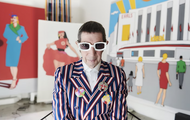In Conversation with Artist Duggie Fields
Posted by Cass Art on 27th Oct 2020
An instantly recognisable figure with his trademark sharp outfits, black quiff and cartoon shades artist Duggie Fields has been an active member of the British art scene for more than five decades. Despite his concern with the identity-dissolving impact of mass media on the contemporary psyche, Duggie has always managed to sustain a coherent signature style that is as flamboyantly dysfunctional as it is cool and simple as his appearance every bit embodies his post-pop art masterpieces. We were delighted to chat to Duggie about his practice, how his own personal style relates to his work and how the current pandemic has affected his life and production of art.
Duggie, firstly thanks so much for taking time out of your busy schedule to speak to us. I wanted to start by speaking about your undeniable unique aesthetic, with your combination of graphic imagery and such strong use of colour, it makes them instantly recognisable as a Duggie Fields. When did you first adopt/discover this distinctive style?
It’s an evolution... I think it became recognisable in art school. I went through quite a journey there and the paintings I left with, you can see them still in what I’m doing now. There’s an information of me in them and it sort of lasts somehow. In art school I went through quite a lot of changes. When I came to college I had a very minimal, conceptual, constructivist period. Before I got to art school I was more about abstract expressionist work and my constructivist period was about geometry and formulas. Gradually I started seeing things in what I was painting and they started becoming deliberately figurative but from a very constructivist viewpoint in that they really bore more relation to geometry than the figure but they have figures in them. But I still think of myself as a constructivist though – I construct images.
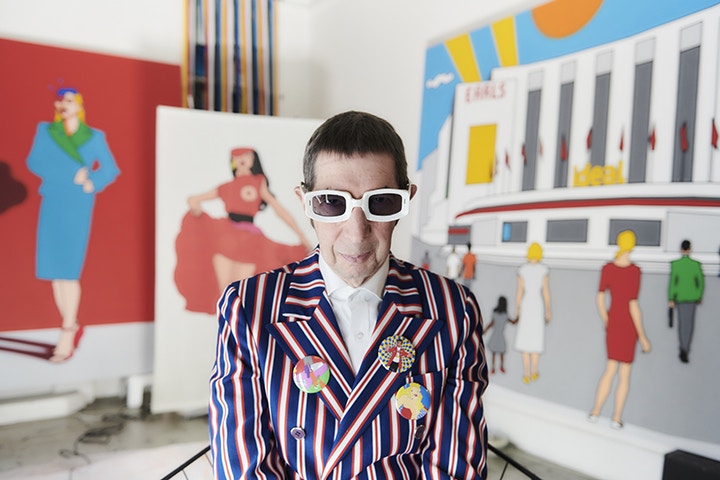
You’ve described your work as Post-Pop Figuration, could you elaborate on this?
That’s partly generational in that, when I was a student Pop Art was in studios/galleries, also I was always into comics as a child and a young adult. But of course comics were a different thing to what they are today and the world is a different place in terms of the visual world, in what was available to be seen has changed dramatically. So I had to react against what was around me, because that’s what you do when you’re youthful - you react against it all, you may be influenced by your surroundings but you’re reacting against them.
I had a brief period in architecture school and I always really loved geometry, and just loved the tools of technical drawing so I took these with me through art school. I’d draw my figures on graph paper and tracing paper with a ruler, making patterns in the drawing that were to do with a grid more then to do with describing anatomy. I still carry that approach with me today. From a digital perspective I would also generally have the same approach in drawing a grid on screen. I always have had this pattern of making things before I start painting. So I don’t start a piece until I know exactly what’s going in the painting. It's partly because of the way I paint, as when you make a large structural grid it will always show through the paint and I would like not to have anything interfere with the surface. So I make lots of studies before with graph and tracing paper but now I use computer imagery and once it’s on computer it simply allows me to do other things with it these days.
So the production of these pieces is of a quite strict rigorous structure. Is there any room for spontaneity?
Well really the whole thing is spontaneous and there’s a point where I think I’ve got to manifest this, so with the painting I’ve got to stop, but on the computer the sound and vision keeps evolving so it stops me, with painting It also stops me. For example right now I'm painting and I’m using a 000 brush and a large canvas and the canvas is just a little bit clumsy but I’ve got to restore it, I’ve been on this one piece since last year. I started it on my computer and let the image evolve and once it’s got to a certain stage, that’s it and allow it manifest itself on the canvas. So there’s a lot of physical hard work and focus. That’s actually what I’m doing now is focusing on edges with this piece – I’m trapping something that’s not quite trapped.
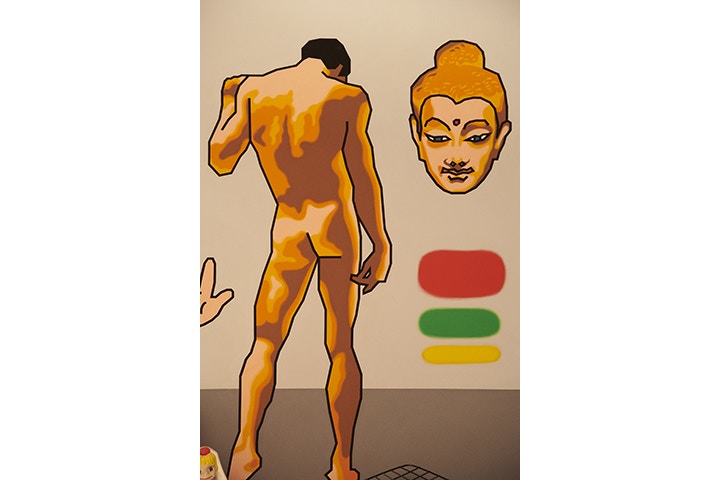
What products do you use and why are they essential for your practice?
I started with acrylic paint back in art school and that was actually a new product at the time but before then mainly oil – the thing with paint is you live with it, it’s with you it gets everywhere, all over you! With linseed oil and turps I’m not allergic to them but I have smell issues with both. Some people love the smell of oil paint/mediums and it’s a big attachment to them when they’re working, but for me it was the opposite, made me feel sick! So acrylic has much less of a smell and using it as my paint medium of choice forced the way I paint to grow in ways that work for acrylic and wouldn’t necessarily work with oil. So that’s an evolution in itself rather than a conceptual reason. I did go through a period where I made my own paints from liquid mediums but health and safely doesn’t really allow them to be sold to the pubic anymore so mostly I use readymade paints, but of course I still mix colours and mix mediums in quite often.
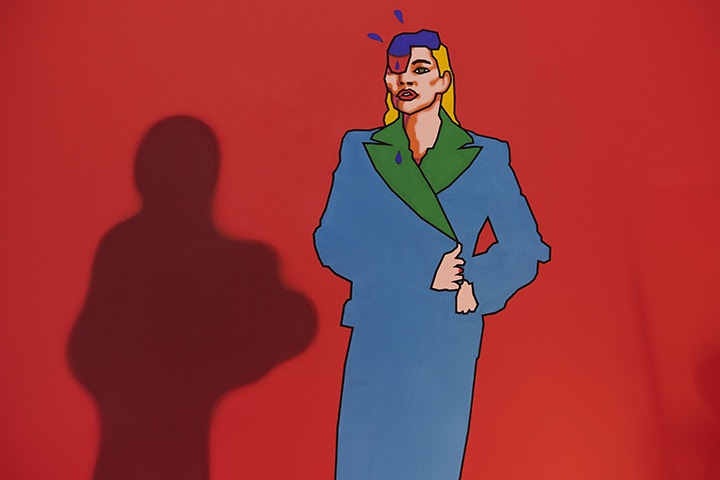
Similar to some of your peers, your art seems to lend itself to your own personal aesthetic. Do you see this as part of your practice or something completely separate?
I’m part of my art and my art is part of me - I cannot separate the two. I’ve always made things all my life, as a child I would just make things but not call it art. It took me a long time to call it art generally. But it’s all around me. I live where I work and everything in my home is work stuff really because it’s thought space, its visual space where I hang things or make objects the affect the space or the space affects them so it’s all quite interactive. So I can’t separate the functions from living and working. Happily I should add.
It’s just how I’ve evolved. I’ve always thought one’s own pattern is one’s own pattern and everybodys pattern is unique and you can trace the roots, for example when I lived with my parents I started painting when I was an early teenager and living at home I had to paint in the bathroom as there was just nowhere else. Then when I left home I had one room to live and work in, even in this flat I’m in now when I first moved in I shared the flat with people and just had one room so had to do everything in that room.
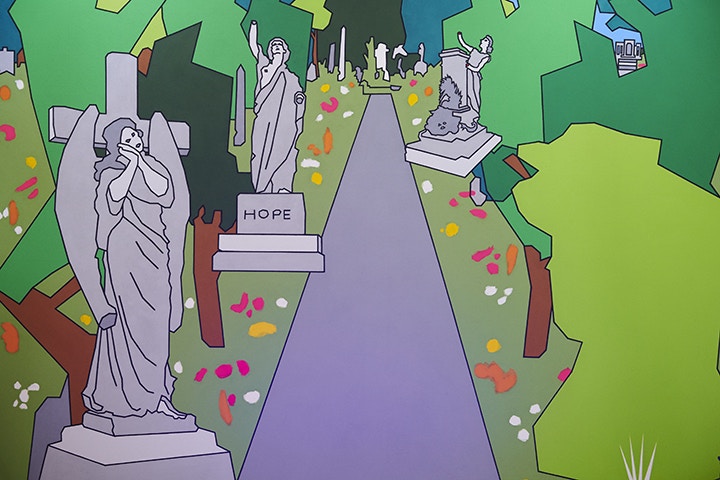
The last few months have been so strange for us all personally and professionally. We’ve been speaking to quite a few artists about how their practice has been affected and the responses have been varied to say the least. From it being detrimental to some, inspiring to others, and for some just a time to reflect and take stock. How have you have you found the last few months from a creative perspective?
In some sense there has been no change for me as I live and work in the same space, no travel and I have some periods where I don’t go out much because I’m just doing my thing at home. So on that level it hasn’t affected me much but from a social perspective I don’t actually socialise too much and I live with someone, not on my own. But living on your own over the last few months must be very hard for people. I havent been to any exhibitions and I’ve missed that and really missed the openings, those random encounters with people who are interested in the space as you are.
The last thing I went to was the Andy Warhol show at Tate Modern, It’s a really good show and it had a good opening too, so that combination of a good show and opening doesn’t always happen. That was my last social event and thankfully I really enjoyed that evening which is has grown in my mind as it was my last interactive experience with someone in an art gallery setting. Although I’m very familiar with Warhol’s work I still found it very interesting. It brought back a lot of memories as I used the visit the Factory whenever I went to New York. So those kind of events I miss of course.
It has influenced some of the work I’ve made with figures wearing masks and also some of the words and in some cases the sound also so I guess it has yes.
You’re a fervent Instagrammer, what do you make of social media and its impact in the art world?
My world has been enriched by it, what I love is visual. I see so much on Instagram that I would not see in life. Many years ago I used to go to WH Smith and go and read magazines and look at imagery but I had to stop because as the years went by they became full of the same adverts, but sadly my local magazine and book shops vanished. So those sources vanished in the real world. But then you have Instagram which presents you with millions of images literally. Also it links you to people as well, so you get a degree of social interaction, I’ve had a lot of interactions with people who I’ve not met and probably never will meet especially with travel the way is in the current climate. But other peoples creativity too - love seeing that. So there is an amazing wealth there - how ever many galleries you have been to, you’re seeing curated visions whereas on Instagram you can connect to creators much easier. So, first thing in the morning I look at Instagram, last thing at night I look at Instagram. I have no shame saying that, some people think there is something wrong with being on that social platform but I think especially during lockdown it’s been a great thing as one hasn’t been able to socialise, meet people casually and have random encounters but on Instagram you can. I currently talk to someone in Georgia and I admire what he makes and the feeling seems to be mutual, over the last few months we had really interesting chats and it’s nice to know that creativity is everywhere.
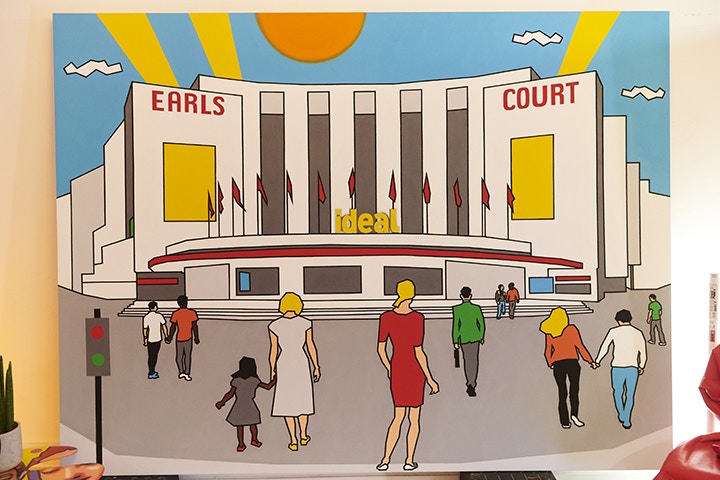
I’ve grown through an era where when I was a child there was no television, then it came into my life with one channel in black and white. Then the telephone was something fixed against the wall in the hallway and you weren’t allowed to spend time on it as it was expensive. Then the TV developed a bit so it was on for longer as it wasn’t on for twelve hours a day when it started, at the same time I got a record player and had some control over the music I heard, as you only heard a little bit of music on the radio, but not pop music, it wasn’t on for more than a few hours a day. So getting a record player was such a big thing for me.
But then TV created more channels therefore more choice, the phone added the function of an answering machine but still fixed. So lots of new developments, then the Internet came about in the mid-90s but without the concept of social media of course as the idea wasn’t conceived. I got a computer in ’96 thinking I was going to arch over my past and do collages as I hated cutting up things. But then I discovered I could draw on it so that became a tool. I really liked social media when it started as it was somewhere I could put my work.
It’s almost like having a portable portfolio or online gallery of your work.
Exactly, and now we travel around with our smart phones and wonder how did we live without it? I used to paint holding my landline in one hand and the receiver scrunched against my shoulder and neck whereas right now I have an ear piece and I’m comfortable to talk and work at the same time. I sing the praises of Bluetooth earphones to my friends which I recently was persuaded to get. The joy of simply freeing up your hands! I just admire people who make things.
Check out Duggies latest video The Age of Uncertainty below:
You can follow Duggie's work on his Instagram here.
FEELING INSPIRED?
Shop online for everything you'll need. Don't forget to hashtag #cassart on social media to show us your creations
